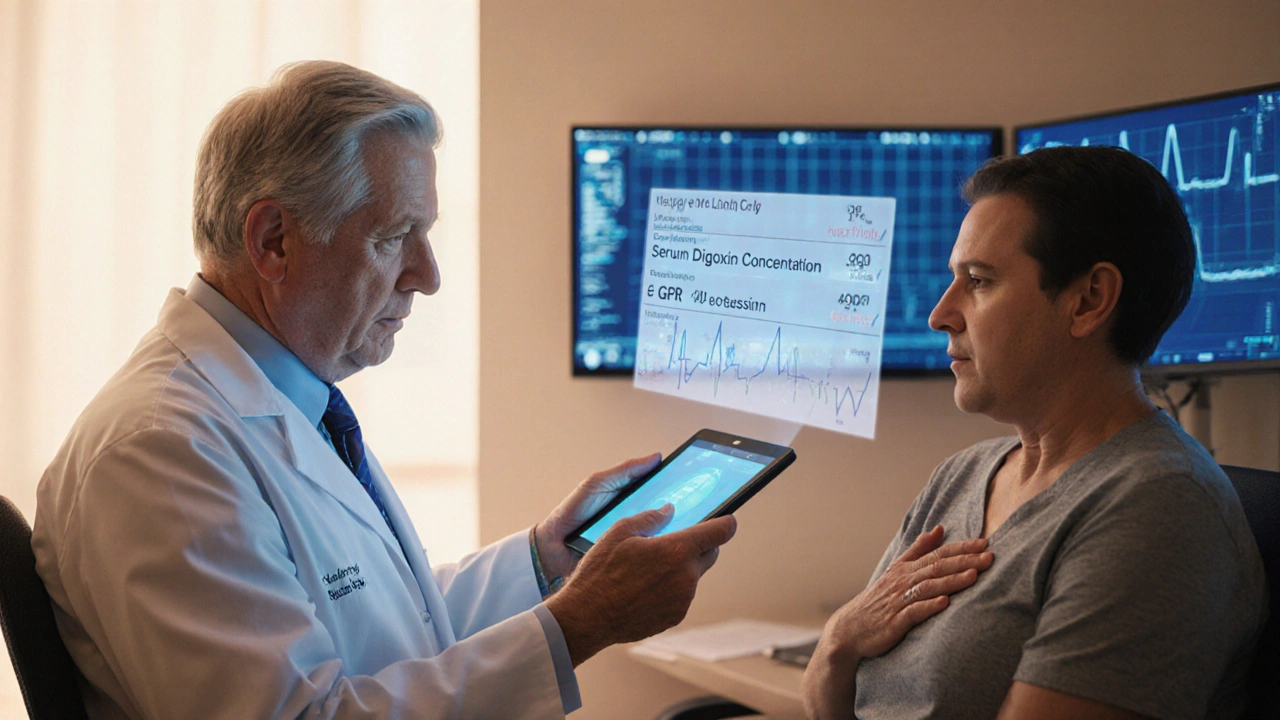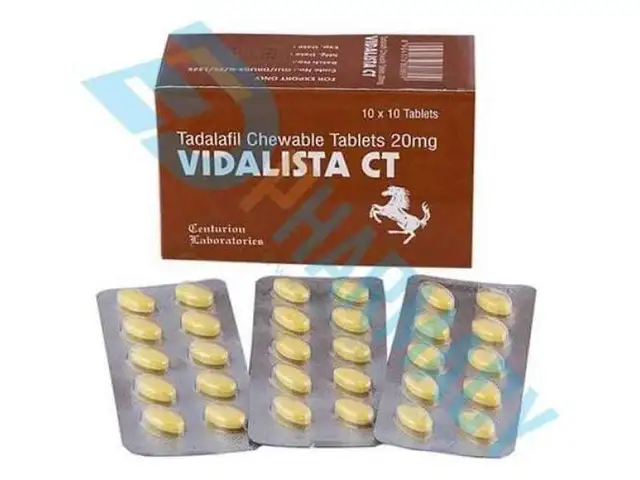
Digoxin vs Alternative Heart Medications Comparison Tool
Mechanism: Inhibits Na⁺/K⁺-ATPase pump → increased intracellular calcium and vagal activation
Indications: Heart failure, atrial fibrillation (rate control)
Monitoring: Serum digoxin levels, renal function, electrolytes
Side Effects:
- Nausea, vomiting, visual disturbances
- Arrhythmias (especially at toxic levels)
- Confusion and fatigue
Mechanism: Blocks β₁-adrenergic receptors → decreased heart rate and contractility
Indications: Hypertension, angina, atrial fibrillation (rate control)
Monitoring: Heart rate, blood pressure
Side Effects:
- Bradycardia, fatigue, cold extremities
- Worsening heart failure in some cases
- Exacerbation of asthma or COPD
Mechanism: Blocks L-type Ca²⁺ channels → decreased AV-node conduction
Indications: Rate control in atrial fibrillation, hypertensive emergencies
Monitoring: Heart rate, blood pressure, liver enzymes
Side Effects:
- Constipation, edema, headache
- Severe hypotension in some patients
- Worsening heart failure
Advantages of Digoxin
- Effective for rate control in elderly patients
- Beneficial for heart failure patients
- Can be used in patients with renal impairment
- Long half-life allows once-daily dosing
Limitations of Digoxin
- Narrow therapeutic window (0.5–2.0 ng/mL)
- Requires regular monitoring
- Drug interactions common
- Not suitable for acute situations
Note: Amiodarone is a powerful antiarrhythmic but carries significant long-term toxicity risks including pulmonary fibrosis, thyroid dysfunction, and skin discoloration. It requires extensive monitoring and is typically reserved for refractory cases.
Use this guide to help determine which medication might be most appropriate based on patient characteristics:
Recommended Treatment:
Quick Takeaways
- Digoxin is a cardiac glycoside that improves heart contraction and slows heart rate.
- Beta‑blockers (e.g., atenolol) and calcium‑channel blockers (e.g., diltiazem) are common alternatives for rate control.
- Amiodarone offers powerful rhythm management but carries long‑term toxicity risks.
- Choosing a drug depends on kidney function, heart rhythm, comorbidities, and monitoring ability.
- Therapeutic drug monitoring is crucial for Digoxin but not usually needed for most alternatives.
What is Digoxin?
When rapid rate control is needed, Digoxin stands out as a time‑tested option for certain heart conditions.
Digoxin is a cardiac glycoside derived from the foxglove plant, used primarily to treat heart failure and atrial fibrillation. It works by inhibiting the sodium‑potassium ATPase pump, which increases intracellular calcium and strengthens heart muscle contractions. At the same time, it enhances vagal tone, slowing conduction through the atrioventricular node.
How Digoxin Works
The inhibition of the Na⁺/K⁺‑ATPase pump leads to a cascade: sodium builds up inside cardiac cells, the sodium‑calcium exchanger slows down, and calcium stays inside the cell longer. More calcium means a stronger squeeze with each beat - a benefit for patients whose hearts pump weakly.
Its vagomimetic effect reduces heart rate, making it especially useful for controlling ventricular response in atrial fibrillation when patients cannot tolerate beta‑blockers.
When Digoxin Is Typically Prescribed
Guidelines recommend Digoxin for:
- Chronic heart failure with reduced ejection fraction, when patients remain symptomatic despite ACE inhibitors and diuretics.
- Atrial fibrillation with rapid ventricular response, particularly in sedentary or older patients where beta‑blockers may cause fatigue.
- Patients with coexisting renal impairment, provided dose adjustments are made and serum levels are monitored.
Because Digoxin has a narrow therapeutic window (0.5-2.0 ng/mL), regular blood tests are essential.
Major Alternatives to Digoxin
Three drug classes dominate as alternatives for rate or rhythm control in heart failure and atrial fibrillation:
- Atenolol is a selective beta‑1 blocker that slows heart rate and reduces myocardial oxygen demand.
- Diltiazem is a non‑dihydropyridine calcium‑channel blocker that decreases AV‑node conduction and relaxes vascular smooth muscle.
- Amiodarone is a class III antiarrhythmic that blocks potassium channels, prolonging repolarization and stabilizing cardiac rhythm.
Each alternative has its own strengths and drawbacks, which become clearer when placed side‑by‑side with Digoxin.
Comparison Table: Digoxin vs Common Alternatives
| Attribute | Digoxin | Atenolol (Beta‑blocker) | Diltiazem (Calcium‑channel blocker) | Amiodarone (Antiarrhythmic) |
|---|---|---|---|---|
| Primary Mechanism | Inhibits Na⁺/K⁺‑ATPase → ↑ intracellular Ca²⁺, vagal activation | Blocks β₁‑adrenergic receptors → ↓ heart rate & contractility | Blocks L‑type Ca²⁺ channels → ↓ AV‑node conduction | Blocks K⁺ channels → prolongs action potential duration |
| Key Indications | Heart failure, atrial fibrillation (rate control) | Hypertension, angina, atrial fibrillation (rate control) | Rate control in atrial fibrillation, hypertensive emergencies | Ventricular tachycardia, atrial fibrillation (rhythm control) |
| Onset of Action | 1-2hours (IV), 6-8hours (oral) | 30-60minutes | 30-60minutes | Hours to days (loading dose required) |
| Half‑Life | ~36hours (renally cleared) | ~6-9hours | ~3-5hours | ~58days (highly variable) |
| Monitoring Needs | Serum digoxin concentration, renal function, electrolytes | Heart rate, blood pressure | Heart rate, blood pressure, liver enzymes (rare) | Thyroid function, pulmonary function, liver enzymes, ECG |
| Common Side Effects | Nausea, visual halos, arrhythmias (if high level) | Bradycardia, fatigue, cold extremities | Constipation, edema, headache | Pulmonary toxicity, thyroid dysfunction, skin discoloration |

Decision Criteria: When to Choose Digoxin Over Alternatives
Clinicians weigh several factors:
- Renal Function: Digoxin is cleared by the kidneys. In patients with eGFR<30mL/min, dose reduction and close monitoring are mandatory. Beta‑blockers are often safer in severe renal impairment.
- Rate vs Rhythm Control: If the goal is simply slowing the ventricular rate, beta‑blockers or diltiazem may be preferred because they don’t require serum level checks. For patients who need both inotropy (strengthening contraction) and rate control, Digoxin offers dual benefits.
- Comorbidities: Asthma or chronic obstructive lung disease can limit beta‑blocker use, pushing clinicians toward Digoxin or calcium‑channel blockers. Conversely, patients with existing thyroid disease should avoid amiodarone.
- Adherence & Monitoring Capacity: Digoxin’s narrow therapeutic window demands regular labs. If a clinic cannot provide frequent testing, a beta‑blocker might be the pragmatic choice.
- Drug Interactions: Numerous medications (e.g., verapamil, quinidine, macrolide antibiotics) raise digoxin levels. In poly‑pharmacy situations, agents with fewer interactions are safer.
By mapping each patient’s profile against these criteria, you can decide whether Digoxin’s unique inotropic effect outweighs its monitoring burden.
Practical Tips for Safe Digoxin Use
Even though Digoxin is an old drug, modern practice still benefits from clear safety steps:
- Start Low, Go Slow: Typical loading dose is 0.5mg IV or 0.25mg orally, followed by maintenance of 0.125mg daily for most adults. Adjust for weight<70kg or eGFR<50mL/min.
- Check Electrolytes: Low potassium or magnesium magnifies digoxin toxicity. Aim for K⁺>4.0mmol/L before initiating therapy.
- Schedule Labs: Measure serum digoxin concentration 6-8hours after the third dose (steady state). Target 0.5-0.9ng/mL for heart failure, 0.8-2.0ng/mL for atrial fibrillation.
- Watch for Toxicity Signs: Nausea, anorexia, visual disturbances (yellow‑green halos), and premature ventricular beats signal high levels.
- Educate Patients: Explain that over‑the‑counter meds like antacids or certain herbal supplements can raise digoxin levels.
Frequently Asked Questions
Is Digoxin still relevant in 2025?
Yes. While newer agents dominate first‑line therapy, Digoxin remains valuable for patients needing inotropic support combined with rate control, especially when renal function is stable and monitoring resources are available.
How does Digoxin compare to beta‑blockers for atrial fibrillation?
Beta‑blockers primarily slow heart rate via sympathetic blockade and have a wide safety margin. Digoxin also slows rate but adds positive inotropy, which can help heart‑failure patients. However, Digoxin requires serum level checks, whereas beta‑blockers generally do not.
Can I take Digoxin with amiodarone?
Co‑administration raises digoxin levels by up to 50% because amiodarone inhibits P‑glycoprotein transport. If both drugs are essential, reduce the digoxin dose and monitor serum concentrations closely.
What are the key side effects that signal digoxin toxicity?
Early signs include nausea, vomiting, loss of appetite, and visual disturbances like yellow‑green halos. Cardiac manifestations-such as premature ventricular beats, AV‑block, or ventricular tachycardia-appear as toxicity worsens.
Is it safe to use Digoxin in the elderly?
Elderly patients often have reduced renal clearance, so lower initial doses (0.125mg) and tighter monitoring are recommended. When dose adjustments are made, Digoxin can be safe and effective for this age group.





Holly Hayes
October 6, 2025 AT 17:16Honestly, the digoxin chart feels like a pretentious lecture for the uninformed, uw.
Matthew Shapiro
October 15, 2025 AT 21:46The comparison does a solid job outlining mechanisms, but I’d stress the importance of individual patient tolerance. Monitoring electrolytes is crucial, especially with digoxin. For beta‑blockers, watch for bradycardia in the elderly. Diltiazem’s edge is its effect on blood pressure, yet it can worsen heart failure. Overall, the table is a handy reference.
Julia Phillips
October 25, 2025 AT 02:16Reading through the side‑effect lists feels like watching a drama unfold on a hospital ward. Imagine an elderly patient juggling visual halos from digoxin and the cold hands of atenolol – it’s almost theatrical! Yet the truth is stark: each drug carries its own script of risks. The empathy needed when choosing is what truly matters. Thank you for laying it out so vividly.
Richa Punyani
November 3, 2025 AT 06:46Esteemed colleagues, I appreciate the thoroughness of this comparative analysis. The inclusion of renal considerations for digoxin demonstrates clinical prudence. Moreover, the clear delineation of monitoring parameters aids decision‑making. It is imperative, however, to acknowledge the sociocultural dimensions of medication adherence. Patients from varied backgrounds may perceive side‑effects differently. I trust that this guide will serve both novice and seasoned physicians alike. Let us continue to prioritize patient‑centered care.
Bhupendra Darji
November 12, 2025 AT 11:16I concur with the points raised above, especially regarding renal function. Adjusting digoxin dosage in impaired kidneys can prevent toxicity. A collaborative approach ensures safety.
Robert Keter
November 21, 2025 AT 15:46When we embark upon the intricate journey of cardiac pharmacotherapy, myriad factors coalesce into a tapestry of clinical nuance. First, the pharmacokinetic profile of digoxin, with its protracted half‑life, demands vigilant serum level surveillance, lest toxicity creep unseen. Second, beta‑blockers, exemplified by atenolol, offer a rapid onset yet may precipitate bradyarrhythmias in susceptible ancestries. Third, the calcium‑channel antagonist diltiazem bestows vasodilatory benefits but carries the specter of peripheral edema. Fourth, amiodarone’s formidable antiarrhythmic power is counterbalanced by a litany of long‑term organ toxicities that no clinician can ignore. Fifth, patient comorbidities such as chronic obstructive pulmonary disease render certain agents less favorable, steering us toward alternatives with minimal respiratory impact. Sixth, the socioeconomic milieu influences drug accessibility, making less expensive options occasionally more pragmatic. Seventh, genetic polymorphisms affecting P‑glycoprotein can alter digoxin clearance, prompting genotype‑guided dosing. Eighth, dietary potassium status interacts profoundly with digoxin’s arrhythmogenic potential, necessitating dietary counseling. Ninth, the physician’s clinical experience, honed over years, informs the subtle art of selecting the optimal agent. Tenth, interdisciplinary collaboration with pharmacists enhances medication reconciliation and monitoring. Eleventh, the emerging field of digital health offers remote telemetry to catch early signs of toxicity. Twelfth, patient education remains the cornerstone; a well‑informed patient is less likely to miss doses or ignore warning signs. Thirteenth, the evolving guidelines continually reshape our therapeutic hierarchies, urging us to stay current. Fourteenth, adverse effect profiles must be weighed against quality‑of‑life considerations, especially in geriatric populations. Fifteenth, the ultimate goal remains the amelioration of heart failure symptoms and the prevention of catastrophic arrhythmias. In sum, each medication is a piece of a grand puzzle, and only through comprehensive, patient‑specific appraisal can we assemble the picture of optimal care.
Rory Martin
November 30, 2025 AT 20:16One must consider hidden influences; the pharmaceutical lobby often skews data presentation. Beware of selective reporting, especially in older trials.
Maddie Wagner
December 10, 2025 AT 00:46This guide really shines when it tackles the emotional side of prescribing. Patients fear “strong” drugs like amiodarone, yet sometimes they need that power. Highlighting the balance between efficacy and quality of life is a compassionate touch. Kudos for making the science accessible!